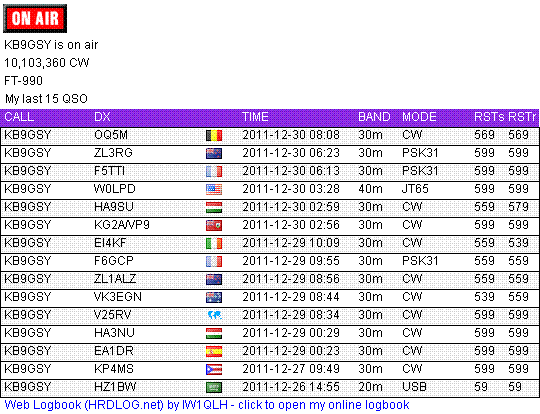I totally don’t like CW skimmers and all that stuff, especially in contesting, but I must admit I like the Reverse Beacon Network and its possibilities. After a contest I like to compare signal levels on different bands with my competitors. It also gives an immediate insight in ‘who of them was on what band at what time’. You can also use the website and its infrastructure for real time A/B comparisons. Not the subjective human ear and S-meter way, but an objective S/N measurement in dB.
I’ve been especially impressed by the speed at which the average skimmer picks up a CW CQ and feeds it into the RBN. One (1!) simple and clean CQ CQ DE OQ5M OQ5M is enough to be picked up and decoded by a bunch of skimmers over the whole world. The only mistery to me is: why does W3LPL NOT pass my decoded CQ to the normal packet/telnet DX cluster? It picks me up (see images) but it ends there while some calls are passed. Some calls that the W3LPL system seems to label as ‘DX’ while on the other hand ubiquitous stuff à la ON is not fed into the concentional DX cluster. I understand that this filter is applied but I’d love to see me spotted as much as other do by the W3LPL system 🙂
Another nice tool, although not as useful, is the real time log by HRD. If you work someone and look him/her up on QRZ, sometimes this is what you see:

The practical use of this is absolutely zero but it’s nice to see how ham radio developers are embracing web technology. I have discovered more of that lately, and it got me thinking. Oh boy, ON5ZO started thinking…




2 replies on “Reverse Beacon Network”
Hi, Franki – the reason you don’t see the W3LPL skimmer fowarding spots of you to the global cluster system is that Frank has put a lot of filtering on what spots he does forward. There were a lot of complaints about W3LPL spots and how most people couldn’t hear what he hears. So, he has a lot of filtering and his skimmer generally only forwards validated spots and spots that are rare or semi-rare.
I’ve had discussions with Frank (I’m local to him, operated at his station many years ago) and I have mixed feelings about those spots. The good side is it points out band openings I would never be looking for but the down sides (1. No indication of “Up” or “EU only” and 2. Making it that much harder to be the first one to find and work a rare one before the pileup) tend to wash out the advantages. But, the accuracy of his spots is generally so much higher than the general cluster system, anyway – and technology never stops…
73, John K3TN
[…] warned you last time (here) that I started thinking about some things in Ham […]